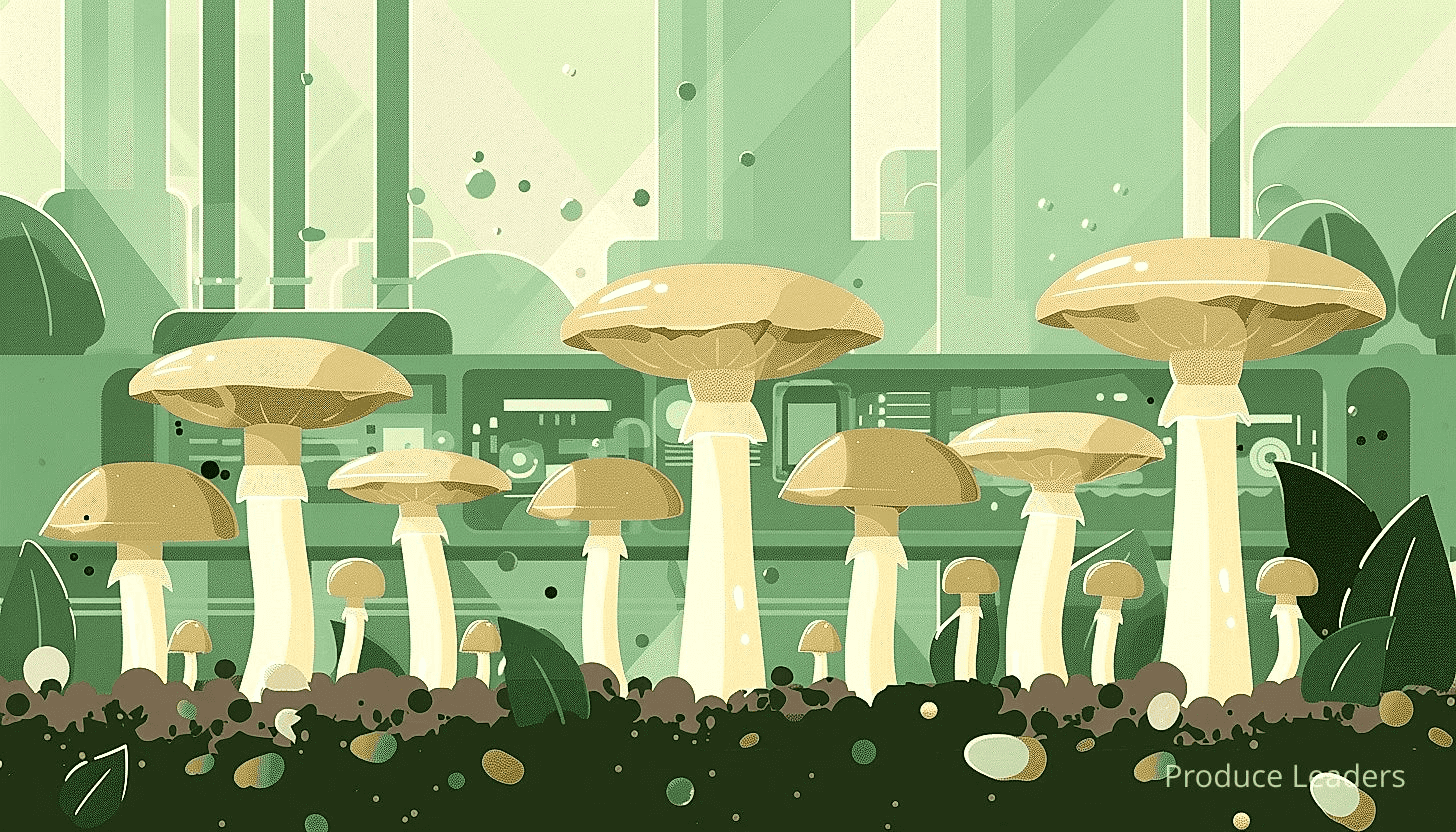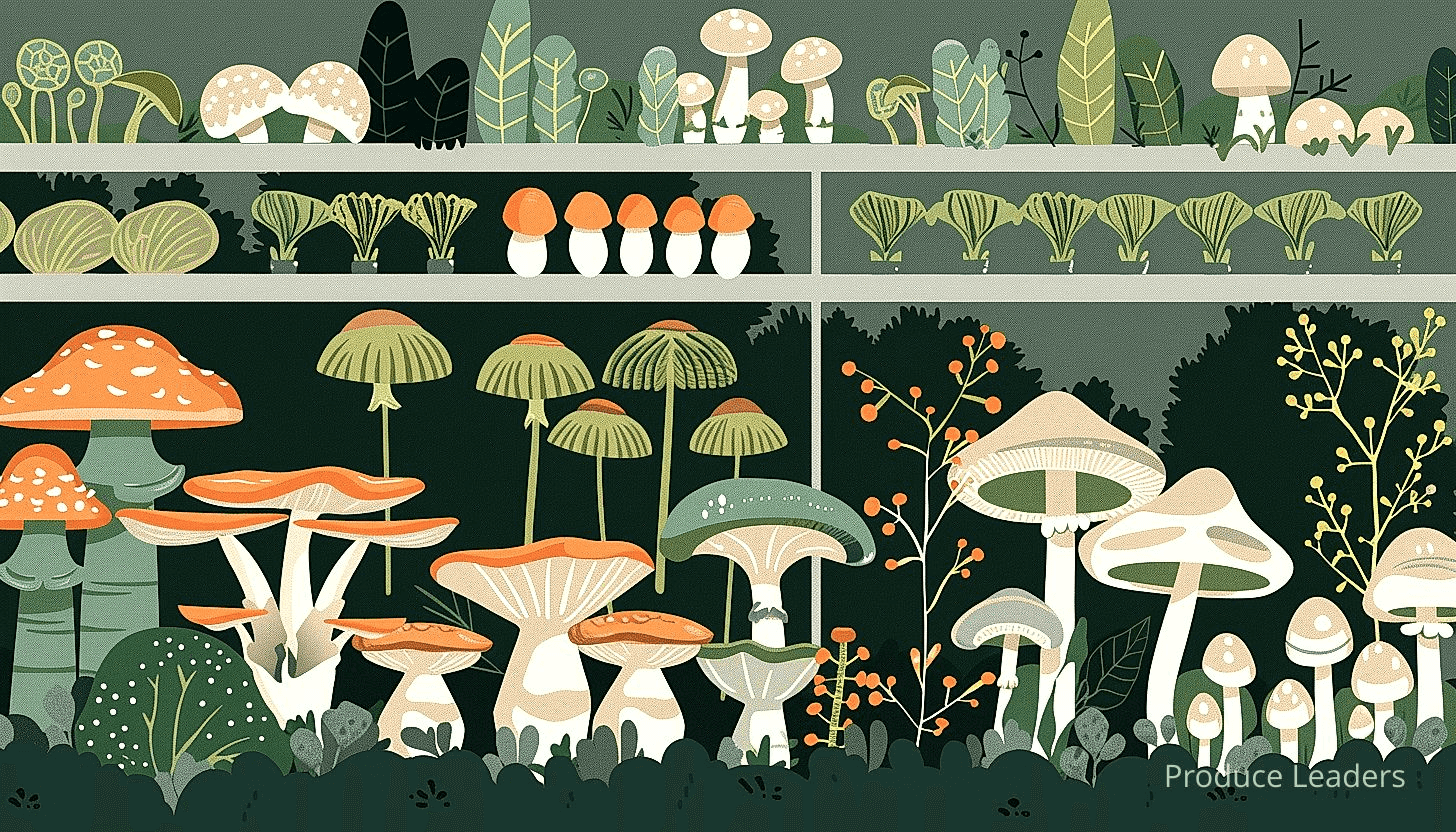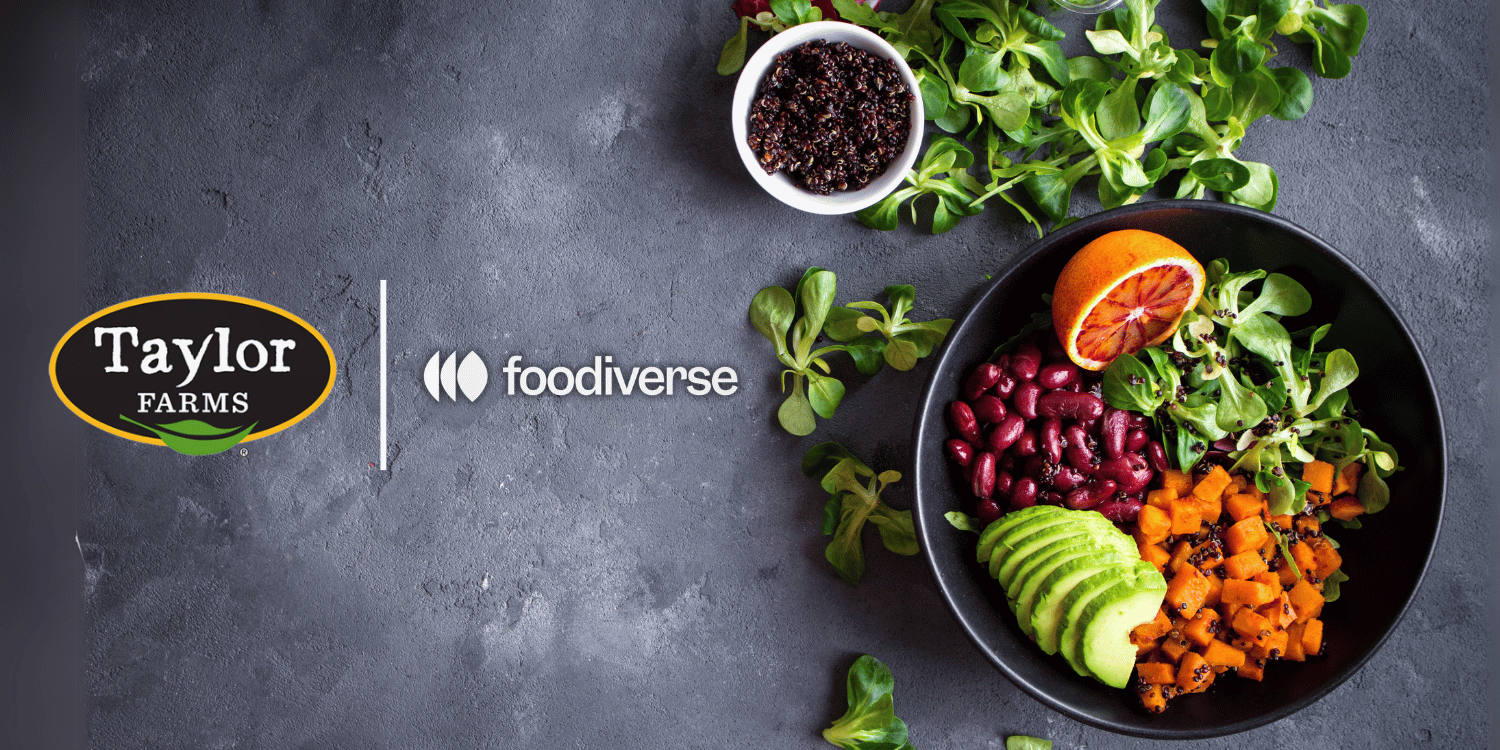Mushrooms are increasingly recognized for their significant health benefits and culinary versatility, making them anticipated as the next star in the produce universe.
They are dense with essential nutrients like Vitamin D, antioxidants, and fiber, providing a healthier option for consumers.
Beyond traditional consumption, mushrooms are gaining popularity as meat substitutes due to their hearty texture and flavor.
Innovations within the agricultural sector, such as indoor vertical farming, are also helping in sustainable and higher production of mushrooms.
Plus, the popularity of specific varieties like reishi, lion’s mane, and cordyceps in the wellness industry boosts their market potential.
Therefore, considering these factors, it is reasonable to predict mushrooms as the next big hit in the produce industry.
- Mushrooms have numerous health benefits and high nutrient density.
- Mushrooms can effectively substitute meat due to their texture and nutrient profile.
- The variety of mushrooms available has significantly increased, thanks to recent innovations in mushroom farming.
- Due to their health benefits, mushrooms are gaining popularity in the wellness industry.
- Mushroom consumption trends and farming prospects promote mushrooms as the future produce.
Moving forward in this article, we will explore the development of mushroom cultivation and the innovative techniques that have contributed to the plethora of varieties available today.
Not only that, but we will also take a deeper look at exactly why mushrooms are beginning to take center stage in the well-being and fitness industry.
There’s also a fascinating section delving into detailed analyses of consumption trends, further substantiating the idea of mushrooms as a future food staple.
These insights are valuable for everyone – whether you are a fitness enthusiast, a sustainable farming advocate, or simply interested in nutrition and health. Let me tell you, let’s press on and uncover more intriguing insights about mushrooms.
Contents
- What Are the Health Benefits of Mushrooms?
- Mushrooms’ Nutrient Density Explained
- How Do Mushrooms Substitute Meat?
- The Rise of Mushroom Varieties
- Innovations in Mushroom Farming
- The Impact of Indoor Vertical Farming
- Why Mushrooms are Preferred in the Wellness Industry?
- Mushroom Consumption Trends
- Prospects of Mushroom Farming
- Why Mushrooms are the Future Produce?
- The Bottom Line
What Are the Health Benefits of Mushrooms?
In Short: Mushrooms, often overlooked in diets, are rich in nutrients and offer numerous health benefits including boosting immunity and promoting heart and nerve functions. Including mushrooms in your meals can aid digestion, maintain a healthy weight, and even help fulfill your nutritional needs as part of a balanced diet and healthy lifestyle.
Many of us often overlook the humble mushroom, don’t we? This underappreciated plant has numerous health benefits, and it’s right there in your grocery store.
Thought of as a mere topping or ingredient in meals, this fungi actually can play a more prominent role in our diet and health. But what can consuming more mushrooms do for us?
Countless types of mushrooms exist, each with its own texture, flavor, and nutritional profile. Broadly speaking, mushrooms are rich in various nutrients, and they have several health benefits linked to them.
Well, the most common species, such as cremini, shiitake, and portobello, are great sources of B vitamins. These vitamins assist in heart and nerve functions, not to mention how they aid in extracting energy from food.
Also, these little powerhouses are excellent sources of minerals, including selenium and copper. We all know that we need these minerals for a strong immune system and blood vessels, right?
They also provide hard-to-find nutrients like ergothioneine, a potent antioxidant that helps protect cells. It’s worth noting, however, that nutritional content varies slightly between different types of mushrooms.
Before we dig deeper into the health benefits, how can we forget the low-calorie count of mushrooms? The majority of mushrooms contain over 90% water, making them a great low-calorie food choice. And who doesn’t love a tasty meal without the guilt of excess calories?
Here’s a rundown of some of the most remarkable health benefits of including mushrooms in your diet:
- Immunity Booster: Various types of mushrooms contain antioxidants that help strengthen the immune system.
- Rich in Antioxidants: They strongly counter oxidative stress, reducing the risk of chronic diseases.
- Dietary Fiber: Mushrooms are an excellent source of dietary fiber, which aids in digestion and helps maintain a healthy weight.
- Vitamin D: Certain varieties, like maitake and morel, are also rich in Vitamin D when exposed to sunlight.
Impressive, isn’t it? Packed with these robust nutrients, mushrooms sure do play a pivotal role in promoting good health.
But do remember, while mushrooms are chock-full of benefits, they’re not substitutes for a balanced diet. They are beneficial when included as part of a varied and balanced diet and a healthy lifestyle. Isn’t it encouraging to know that integrating mushrooms into your meals can bring you one step closer to fulfilling your nutritional needs?
Fungi might be the last thing on your mind when you think of nutritious foods. But isn’t it time that we started giving the humble shrooms the attention they deserve in the world of nutrition?
So next time you’re in the produce section, looking at the varying types of mushrooms, think about all the ways they could improve your health. After all, the humble mushroom might just be the next big thing in the produce universe, wouldn’t you say?
Mushrooms’ Nutrient Density Explained
In Short: Mushrooms boast a high nutrient density with essential nutrients such as protein, fiber, B vitamins, potassium, selenium, and vitamin D, alongside low calories, sugar, and fat making them ideal for a balanced diet. Beyond their nutrient profile, these fungi also contain functional compounds like beta-glucans and ergothioneine, which respectively bolster immune function and protect cells from damage.
When it comes to nutrition, mushrooms are a true powerhouse. They offer incredible health benefits while being low in calories.
Who wouldn’t want that, right? The caveat, however, lies in knowing their particular nutrient profile.
Have you heard of their high protein and fiber content? Yes, these fungi are packed with both essential nutrients.

They’re also an excellent source of B vitamins. These contribute to nerve health and keep your metabolism running efficiently.
Besides, they’re rich in minerals such as potassium and selenium. Among their benefits are blood pressure regulation and body detoxification, respectively.
Another unique feature is they’re one of the few plant-based sources of vitamin D. Isn’t that something?
For those watching their weight, mushrooms are a dream come true. They have very low sugar and fat levels, probably lower than you imagine.
This makes them the perfect choice for a well-balanced diet. The nutritional value they provide is immense in relation to their calorific content.
Let’s take a closer look, shall we?
Nutritional highlights of different mushroom types may help us appreciate their value even more.
- Portobello: High in fiber and niacin (a kind of B vitamin), and low in fat and calories.
- Shiitake: Known for their high lentinan content, a type of sugar that helps boost the immune system.
- White: Excellent source of selenium, riboflavin, and copper.
- Oyster: Low in cholesterol, but high in protein, niacin, and vitamin B12.
- Cremini: Rich in vitamin B5, selenium, and copper – essentials for overall health.
However, it’s not just about the nutrients. Mushrooms also have their share of functional compounds.
Substances like beta-glucans which are known to support immune function. Or the antioxidant ergothioneine, which protects cells from damage.
But what if you’re not a fan of their texture or taste? It happens.
You’re in luck though. Their nutritional value remains almost the same when cooked or used in dishes.
Let me tell you, sneaking them into your diet shouldn’t be that difficult. Right?
While they are widely known as a culinary delight, the nutrient density of mushrooms makes them a star in the produce universe.
Isn’t it time we reconsidered our view of these unsung heroes of the vegetable world?
Don’t forget, it’s not always about the ‘superfoods’ we hear so much about. Sometimes, it’s the humble mushroom that truly deserves our attention.
How Do Mushrooms Substitute Meat?
In Short: Mushrooms serve as a popular meat substitute due to their umami flavor, facilitated by a high glutamate content, and can be creatively incorporated into meals such as burgers, stir-fries, and even ‘bacon’. While they don’t match the protein content of meat, their health benefits like low fat, high fiber and antioxidants, combined with other protein sources, make them a nutritious meat alternative.
When considering meat alternatives, mushrooms often rank high on the list. Why? – you might ask.
Well, these humble fungi have a certain savory, umami quality that resembles the flavor profile of many meats. This distinctive taste is primarily due to their high glutamate content, an amino acid that provides a savory, or umami, flavor.
On the market today, you’ll find a number of brands selling products like mushroom pulled ‘pork’, mushroom ‘bacon’, and even mushroom ‘sausage’. These innovative foods are making it easier for people to substitute mushrooms for meat in ways they might not have originally thought possible.
To appreciate the creative ways mushrooms are replacing meat, let’s look at some favorites:
- Burgers: Portobello mushrooms, with their large, hearty caps, are an excellent stand-in for beef patties.
- Stir-fries: Sliced mushrooms can offer an interesting texture change and a tasty protein alternative in stir-fries.
- ‘Bacon’: Thinly sliced and glazed with smoky seasonings, mushrooms can mimic the flavor and delight of bacon.
Mushrooms not only serve as a delicious substitute, but also offer health benefits. They are low in fat, but high in fiber and antioxidants with the potential of boosting your immune system. Plus, cultivated mushrooms like white button, shiitake, and maitake varieties are often grown in enriched environments and are a good source of Vitamin D.
However, does the nutrition profile of mushrooms truly match up to that of meat? In terms of protein content, it’s important to note that mushrooms can’t quite compete.
While they do provide some amino acids, they’re not a fantastic protein packer on their own. But combine them with other vegetarian protein sources like beans, lentils, or whole grains, and you’ll have a wholesome meal.
Many may ask, are mushrooms the perfect meat analogue? Truth is, they may not be able to fully replicate the taste, texture, and protein content of meats. Yet, their unique flavors, innovative applications, and health benefits certainly place them in the meat alternative hall of fame.
With all the versatility and goodness packed into these little fungi, isn’t it wonderful that we have such delicious and nutritious alternatives available?
Who needs a meat-based diet, when you could enjoy the bountiful flavors and benefits of the unassuming mushroom?
The Rise of Mushroom Varieties
In Short: The variety of mushrooms has expanded beyond the traditional white button to include options like Portobello, Cremini, and Shiitake, revolutionizing culinary experiences. These different types are not just flavor-rich but also possess unique medicinal properties, offering health benefits such as boosting immune systems and brain power.
For decades, when you thought about mushrooms, what likely popped up in your mind was the image of white button mushrooms, commonly found in local grocery stores. They were the staple bit of almost every household kitchen.
However, consider a world beyond that. Have you ever given thought to the range of variances as far as mushrooms go?
The world of mushrooms today comprises of more than mere white buttons. Varieties like Portobello and Cremini are the new black, both for home cooks and professional chefs alike.

While the Portobello with its larger size and more robust flavor often replaces meat in a dish, the Cremini mushrooms are smaller, denser, and chewier. These varieties are quickly becoming a kitchen favorite.
Would you like to add a bit of gourmet flair to your cooking? If so, consider the classy Shiitake variety.
Shiitake mushrooms have an umami-rich flavor and a meatier texture than most. They are considered food and medicine in many cultures.
Indeed, the next time you visit your grocer, you may be surprised by the worldly fungi in the fresh produce aisle.
Do you need some help navigating these options? Here are the top mushroom varieties you should know:
- White button mushrooms, classic and versatile.
- Portobello mushrooms, perfect for grilling.
- Cremini mushrooms, great for stir fry dishes.
- Shiitake mushrooms, with their gourmet umami flavor.
It’s prudent to point out that the mushroom frenzy doesn’t end there.
Ever heard of Oyster mushrooms? These scallop-edged caps can be gray, pale yellow, or even blue. They render a delicate, slightly sweet taste and velvety texture.
Then there is the woodland mystery of Morels, the meaty splash of Chanterelles, and the earthy whisper of Porcini. Aren’t these varieties of mushrooms adding a different layer to our meals?
Moreover, the rise of mushroom varieties isn’t limited to just the culinary scene.
The medicinal world is seeing an increased popularity of varieties like Reishi and Lion’s Mane. Did you know people are turning towards these varieties for their healing properties?
From supporting the immune system to boosting brain power, these mushrooms aren’t shy of benefits. Truly, the mushroom kingdom offers much more than the good old white buttons.
To put it simply, it is a fantastic time to get excited about mushrooms. This newfound profile of mushrooms is revolutionizing the realm of food and nutrition.
Isn’t it a testament to the power of diversity that a simple food like mushrooms can have such a fascinating range of flavors, textures, and benefits?
You will be on your way to numerous gastronomic delights and potentially a healthier lifestyle, will you not, just by experimenting with the rich array of mushroom varieties available?
Innovations in Mushroom Farming
In Short: Innovative technologies such as vertical farming and the use of recycled growth mediums are transforming mushroom cultivation into a sustainable, planet-friendly practice. Digitization, farm mechanization, software applications, strain improvement, and urban mushroom farms also play a significant role in enhancing productivity and the quality of the produce.
Mushroom farming is stepping into a new era, embracing a bouquet of innovative technologies for cultivation. This forward-moving sector is leaving no stone unturned to produce these delectable fungi in a sustainable and planet-friendly way.
Isn’t it fascinating to learn about the steps being taken in this direction? These diligent efforts are brewing a transformation in the world of produce.
The game changer in this sphere has been the integration of modern science with traditional farming practices. This amalgamation has not only enhanced productivity but has also ensured high-quality produce.
But what are these revolutionary technologies that the mushroom farming industry is adopting for sustainable and efficient production?
I’m glad you asked. Let’s dive into the heart of the matter.
Vertical farming, a usually urban agriculture practice, is one such innovation. This method extends the idea of a farm growing “outwards” to “upwards”, maximizing the available space in a given area.
Coupled with controlled environment agriculture, this technology makes growth possible in any weather and any location. This means fresher produce and reduced transportation needs!
Next up is the concept of recycled growth medium. Ever considered coffee grounds as a growth medium for mushrooms?
Well, guess what? Several innovative farmers have successfully made it possible. The nutrient-rich discarded coffee grounds make for a rather fertile ground for mushroom growth.
Allow me to list down a few more innovative technologies finding their place in mushroom farming:
- Farm mechanization: Automated systems help farmers monitor climatic conditions and control them for optimal mushroom growth.
- Software applications: Programs are being designed to aid farmers in managing all farm activities and inventory.
- Strain improvement: Top quality strains are being developed to produce a variety of mushrooms with enhanced nutritional qualities.
Not just that, there’s a rise in the use of urban mushroom farms too. Actions taken by cities to address food security and reduce food miles paved the way to mini urban mushroom farms.
These mushroom farms find their home in small spaces, such as empty garages and spare rooms. Isn’t that a great way to ensure the availability of freshly grown nutritious mushrooms round the year?
With digitalization taking the front seat, the future of mushroom farming does indeed shine brightly. Advanced data monitoring systems are being calibrated to manage farm temperature, humidity and other essential elements, ensuring that every growth cycle is optimized.
Pro Tip: Integrate innovative technologies such as vertical farming, recycled growth mediums and digitalization into your mushroom farming practices to boost productivity, ensure quality, and promote sustainable, planet-friendly growth.
So there we have it, a quick look at some of the ground-breaking innovations transforming the world of mushroom farming. With all the advancements in place, wouldn’t it be safe to presume that these fungi just might be the next star in the produce universe?
Well, it’s something we’ll have to wait and see. With all said and done, the future of sustainable and planet-friendly mushroom farming seems clear – it’s moving up! Just like those mushrooms on the vertical farms.
The Impact of Indoor Vertical Farming
In Short: Indoor vertical farming, known for its space efficiency, reduced water usage, and year-round production capabilities, is gaining popularity as it effectively addresses challenges faced by traditional farming. Particularly, the cultivation of mushrooms shows potential in vertical farming due to their lower water needs, less sunlight requirement, and shorter growth cycle, paving the way for a more sustainable and resilient food system.
Indoor vertical farming has surged in popularity and recognition over the recent years. The viability of more traditional farming methods has been brought into question by various factors, fueling this shift.
Climate change and rapid urbanization are factors significantly straining the capability of conventional agricultural practices. These challenges raise the question, can we continue to rely on traditional farming in the future?
Indoor vertical farming presents itself as a promising solution. And when we look at its benefits and potential, it’s easy to understand why.
Key benefits include the significant reduction in water usage, year-round crop production, and the ability to cultivate plants without the need for soil. Little wonders why it holds such a promising prospect for the future of sustainable agriculture.
Let’s ponder on some key points that make indoor vertical farming shine:
- Space Efficiency: Indoor farms can grow crops vertically, dramatically increasing yield potential per square foot.
- Reduced Water Usage: Precision irrigation used in indoor farming can save up to 90% of water compared to traditional farming methods.
- Climate Control: Indoor farming provides the control to create optimal growing conditions year-round, irrespective of external weather conditions.
Impressed yet?
Indoor vertical farming is, without a doubt, a game-changer tackling the challenges head-on that traditional farming faces today. It’s pushing the envelope on what’s possible in agriculture, and offering new avenues for food production.
Interestingly, the rise of indoor vertical farming isn’t happening in isolation. It coincides with the increasing acceptance and popularity of plant-based foods. And this is where our humble friend, the mushroom, steps into the limelight.
A question pop-ups though, what makes the mushroom the star in this drama of produce?
Mushrooms, with their versatile usage and rich nutritional content, make an excellent candidate for vertical farming. They thrive in controlled environments that vertical farms can provide.
Mushrooms could potentially play a lead role in maximizing the benefit of vertical farming. They consume less water, require less sunlight, and have a shorter growing cycle compared to many other crops. Sounds impressive, doesn’t it?
The adoption of indoor vertical farming has the potential to transform the way we grow and consume mushrooms, making them a more integral part of our diets. But how will that play out, and how will it impact the future of our food system?
The potential of mushrooms to take center stage in the produce universe, paired with the prospect of indoor vertical farming, holds the promise of creating a food system that is more sustainable, resilient, and inclusive. Only time will unveil how this promising future takes shape.
Why Mushrooms are Preferred in the Wellness Industry?
In Short: Mushrooms are valued in the wellness industry for their nutritional content, antioxidants, adaptability, and capacity to boost the immune system, as well as their positive impact on both physical and mental health. These fungi, including types such as Reishi, Chaga, Lion’s Mane, and Cordyceps, have unique properties that promote health and are increasingly used in a variety of wellness products.
Mushrooms, those mildly flavored, often overlooked plants, have increasingly become a superstar in the wellness industry. But why mushrooms, you may ask?
Well for starters, mushrooms are powerhouses of nutritional value. They are low in calories, while being rich in fiber, proteins, vitamins and minerals. Hence, a good fit for those seeking a healthy dietary intake.
Mushrooms are not just about the basics though. They also contain antioxidants, which are crucial in the fight against harmful free radicals. Antioxidants not only prevent age-related diseases but also enhance overall health.
But why does the wellness industry prefer mushrooms specifically? Part of it lies in their unique capacity to boost our immune systems. Mushroom-enhanced products promote immunity, thereby reducing the likelihood of falling ill.
Now let’s break down some of the stars of the mushroom world and their unique attributes that make them a choice element in the wellness industry.
- Reishi mushrooms are renowned for their calming effects, thus, being an excellent addition to stress relieving products.
- Chaga mushrooms, with their high antioxidants content, are a natural choice for skincare formulations.
- The Lion’s Mane mushrooms are celebrated for their cognitive boosting features, find their way into nootropic supplements.
- Cordyceps mushrooms are popular in energy-boosting concoctions, owing to their capacity to enhance physical performance.
It’s not just about their abilities individually, but also the potential of these mushrooms to work synergistically. This attribute of mushrooms, to reinforce each other’s potency when taken together, has caught the attention of many in the wellness industry. They’ve dubbed it as the “Entourage Effect” making these fungi even more appealing.
Moreover, adaptability is another aspect that sets mushrooms apart. These nature’s marvels can grow in varied climates and conditions. Therefore, providing a reliable and scalable source for the wellness products.
Being plant-based, mushrooms are not only an excellent choice for vegans and vegetarians but also for those seeking to reduce their meat intake. As more people turn towards plant-based diets, mushrooms’ protein content makes them a favorite alternative to meat.
No discussion on the mushroom preference in the wellness industry could end without me mentioning their impact on emotional and mental wellbeing. Certain types of mushrooms have shown to possess anti-depressive and mood-enhancing properties. This encourages their incorporation in products aimed at mental health enhancement.
In essence, the preference of mushrooms in the wellness industry hinges on their nutritional value, immune-boosting capabilities, adaptability, and positive effects on both physical and mental health. Hence, making it clear that their rising popularity is indeed well-deserved.
Mushroom Consumption Trends
In Short: Mushrooms are gaining popularity as meat substitutes and nutritional superfoods, with recent consumption trends focusing on their medicinal benefits, culinary versatility, and eco-friendly cultivation. The scope extends beyond food, as mushrooms’ diverse benefits are recognized in the beauty industry and dietary supplements, reinforcing their rising status in the consumer market.
Given the rising interest in our fungal friends, what trends are we witnessing in mushroom consumption?
One prominent shift is towards the use of mushrooms as a meat substitute. Has anyone noticed these products trending on the market?
It’s hard not to. Recent years have seen the introduction of mushroom-derived burgers, sausages, and other meat alternatives appear on supermarket shelves.

Are you becoming curious as yet? Why the sudden appeal for these oft-overlooked kitchen ingredients?
People are beginning to recognize the nutritional benefits of mushrooms. Low in calories yet high in fiber and protein, mushrooms are increasingly viewed as a ‘superfood’.
Beyond nutrition, could there be another factor behind this trend? What drives people’s appetite for these earthy delights?
Flavor trumps all for foodies. With their umami character and chewy texture, mushrooms are near-perfect gastronomic delights.
Now, let’s focus on three highlighted trends shaping the mushroom-centered dietary movement:
- Medical Mushrooms: With proven therapeutic benefits like boosting immune function and mental wellbeing, medicinal mushrooms are becoming a popular category.
- Culinary Creativity: Chefs around the world are using a variety of mushroom species to bring new flavors and textures to dishes.
- Eco-Friendly Production: The cultivation of mushrooms is being acknowledged as environmentally friendly given their carbon-neutral footprint.
Did you know that even the beauty industry is paying attention to mushrooms? It’s not all about what’s on your dinner plate anymore.
From creams and serums to masks, mushrooms are being leveraged for their skin-enhancing properties.
But it’s not just about cosmetics. These superfoods even found their way to dietary supplements.
Has everyone got on board with the mushroom boom?
It appears so. Growing consumer awareness of the diverse benefits and applications of mushrooms is driving this trend.
Who would have thought that a once overlooked fungus could revolutionize various industries? With the pace at which new products emerge, one should stay tuned for what might appear next.
Important: The shift towards using mushrooms as a meat substitute and their recognition as a ‘superfood’ due to their nutritional benefits have contributed to the increased consumer attention, with their various applications spanning from dietary supplements and food to beauty products.
Still, it’s crucial to remember that while mushrooms offer several benefits, they shouldn’t be viewed as a panacea for all health concerns. Maintaining a varied and balanced diet remains the golden rule, right?
Let me tell you, with these ongoing global consumption trends, it seems the humble mushroom is indeed becoming the next star in the produce universe. Interesting, isn’t it?
Prospects of Mushroom Farming
In Short: Mushroom farming, rich in nutritional benefits and demand driven by healthier diet trend, presents a promising prospect in sustainable and cost-efficient agriculture. Additionally, it aids in waste management by recycling agricultural waste into a rich growth medium, reducing carbon footprint, enhancing soil fertility and offers a viable livelihood for those in resource-limited areas.
The trend of healthy eating has made people explore new varieties of agricultural produce. Have you noticed the increasing popularity of mushrooms in recent years?
This isn’t just a fleeting trend. Mushroom farming has the potential to blossom into a significant aspect of agriculture.
Consider the factors that support this view. A mushroom’s nutritional benefits, the low cost of mushroom farming, and the potential it holds for sustainability make it quite promising.
Did you know that mushrooms are packed with a myriad of beneficial nutrients? They’re rich in vitamins, proteins, and fiber which are crucial for a healthy diet.
Hence, the consumption of these fungi might be elevated in the future.
Are you aware of the fact that mushroom farming is cost-efficient? Sure, the initial cost may be high, but the yields you get are worth it.
Mushroom farming doesn’t require large tracts of land to be successful. Isn’t it interesting how you can grow them with relative ease even in urban settings?
Now, let’s enumerate the compelling reasons behind the potential of mushroom farming:
- The mushroom demand is expected to rise as people keep adopting healthier diets.
- With just a small space, we can grow these organisms.
- Low maintenance and potentially high profit make this way of farming notably attractive.
- Due to the recyclable nature of the substrate used in mushroom farming, it promotes sustainability.
Given these reasons, it’s clear that the mushroom demand will indeed surge, and the farming industry is gearing to meet it. Beside these economic factors, did you consider the environmental angle of the topic?
Believe it or not, mushroom farming helps in waste management. Mushroom cultivation uses agricultural waste and turns it into a nutrient-rich growth medium.
Isn’t this an effective way to recycle waste and minimize our carbon footprint? Yes, it sure is, and it’s appealing to eco-conscious people around the globe!
Moreover, farming mushrooms could be a viable livelihood for people residing in areas with limited resources. Would you have ever thought that a simple fungus could lay a pathway for sustainable development?
To add to that, mushroom byproducts can be used as organic fertilizer which enhances soil fertility. From farm to table, and then back to the farm—what an impressive cycle, wouldn’t you agree?
Drawbacks? Sure, there are a few like any other crop. But with proper education and technique, farmers can overcome them. With the right assistance and resources, anyone can become a successful mushroom farmer.
Pro Tip: Invest in understanding mushroom farming as it is cost-efficient, requires minimal space, promotes sustainability, and caters to the growing trend of healthier diets.
After reflecting on these points, doesn’t it seem like we’re on the brink of a mushroom revolution? It’s an interesting perspective that merits further exploration. Care to join us on this exciting journey?
Staying informed is crucial for those interested in farming mushrooms. Are you ready to consider the prospects of mushroom farming?
Why Mushrooms are the Future Produce?
In Short: Mushrooms are emerging as future produce due to their sustainable farming methods, high nutritional value, versatility, and innovative uses in various industries. Their environmental benefits, role in self-care rituals, contribution to plant-based diets, and potential applications in eco-friendly materials further highlight their increasing importance.
Over the past few years, mushrooms have quietly transitioned from a simple stir-fry ingredient to a popular superfood. This incredible fungus, with its astounding nutritional profile, has found its way not only into our kitchens but also our daily self-care rituals.
But why exactly are mushrooms considered the future produce? Let’s dig in into the reasons below.
First and foremost, mushrooms make farming sustainable.
They require less space and water compared to conventional crops, hence they can significantly cut environmental costs.
It’s not just about the environmental benefits though. Can you think of anything more nutritious and versatile?
Mushrooms possess a high nutritional profile, enriched with vitamins, minerals, and essential antioxidants. These aspects are appealing to health-conscious consumers, making mushrooms increasingly popular for their multiple health benefits.
And it doesn’t stop at the dinner table. Have you realized how prevalent mushrooms have become in the beauty and wellness sectors? With numerous beauty products boasting mushroom extracts and medicinal mushrooms gaining prominence, it’s clear that these humble fungi are on the march.
In addition, mushrooms provide meaty substitutes for vegan and vegetarian meals.
Products made from mushrooms, such as mushroom burgers, are a great way to provide meat-like texture without involving any animal products. They cater to the rising demand for plant-based options.
We also can’t overlook the innovative ways that mushrooms are being used.
- Culinary innovations, with mushrooms appearing in everything from tea to chocolates
- Mushroom materials being used as eco-friendly alternatives to leather, polystyrene, and even construction materials
Going beyond its culinary uses, this versatile kingdom of fungi is redefining what it means to be ‘produce’.
Given the combination of sustainability, nutrition, and innovation, it seems evident that mushrooms are the future produce. They have potential beyond our plates and should be on everyone’s radar.
However, looking to the future, the challenge will be how we can further harness these potential uses and benefits of mushrooms.
Will you be on board with this mushroom movement?
The Bottom Line
The manifold health benefits of mushrooms, including bolstering immunity and heart health, pitched them as a prime player in the sphere of superfoods.
Rich in essential nutrients, mushrooms emerge as a versatile component, supreme in their nutrient density as well as taste.
An excellent substitute for meat due to their texture and umami flavor, they prove to be perfect for plant-based diets.
Owing to the growing demand, we’re witnessing a surge in the variety of mushrooms, with each type offering unique nutritional boons.
Innovations in farming techniques, fueled by technological advancements, have vastly improved the efficiency and sustainability of mushroom cultivation.
Indoor vertical farms, specifically, have been a game-changer, substantially enhancing the yield while minimizing the ecological footprint.
Mushrooms are increasingly becoming a central ingredient in wellness and beauty industries due to their therapeutic effects and antioxidant properties.




















